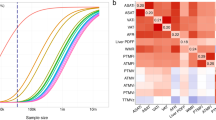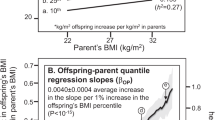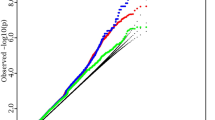Abstract
Background/Objective:
Body mass index (BMI) is a surrogate measure of adiposity but does not distinguish fat from lean or bone mass. The genetic determinants of BMI are thought to predominantly influence adiposity but this has not been confirmed. Here we characterise the association between BMI-related genetic variants and body composition in adults.
Subjects/Methods:
Among 9667 adults aged 29–64 years from the Fenland study, a genetic risk score for BMI (BMI-GRS) was calculated for each individual as the weighted sum of BMI-increasing alleles across 96 reported BMI-related variants. Associations between the BMI-GRS and body composition, estimated by dual-energy X-ray absorptiometry (DXA) scans, were examined using age-adjusted linear regression models, separately by sex.
Results:
The BMI-GRS was positively associated with all fat, lean and bone variables. Across body regions, associations of the greatest magnitude were observed for adiposity variables, for example, for each s.d. increase in BMI-GRS predicted BMI, we observed a 0.90 s.d. (95% confidence interval (CI): 0.71, 1.09) increase in total fat mass for men (P=3.75 × 10−21) and a 0.96 s.d. (95% CI: 0.77, 1.16) increase for women (P=6.12 × 10−22). Associations of intermediate magnitude were observed with lean variables, for example, total lean mass: men: 0.68 s.d. (95% CI: 0.49, 0.86; P=1.91 × 10−12); women: 0.85 s.d. (95% CI: 0.65, 1.04; P=2.66 × 10−17) and of a lower magnitude with bone variables, for example, total bone mass: men: 0.39 s.d. (95% CI: 0.20, 0.58; P=5.69 × 10−5); women: 0.45 s.d. (95% CI: 0.26, 0.65; P=3.96 × 106). Nominally significant associations with BMI were observed for 28 single-nucleotide polymorphisms. All 28 were positively associated with fat mass and 13 showed adipose-specific effects.
Conclusions:
In adults, genetic susceptibility to elevated BMI influences adiposity more than lean or bone mass. This mirrors the association between BMI and body composition. The BMI-GRS can be used to model the effects of measured BMI and adiposity on health and other outcomes.
This is a preview of subscription content, access via your institution
Access options
Subscribe to this journal
Receive 12 print issues and online access
$259.00 per year
only $21.58 per issue
Buy this article
- Purchase on Springer Link
- Instant access to full article PDF
Prices may be subject to local taxes which are calculated during checkout


Similar content being viewed by others
References
World Health Organization ICD-10: The ICD-10 International Statistical Classification of Diseases and Related Health Problems. World Health Organization: Geneva, 1992.
Moody A Adult anthropometric measures, overweight and obesity. In: Craig R, Mindell J (eds). Health Survey for England - 2013. Health and Social Care Information Centre: London, 2014. p 1–39.
Bouchard C . BMI, fat mass, abdominal adiposity and visceral fat: where is the 'beef'? Int J Obes 2007; 31: 1552–1553.
Shah NR, Braverman ER . Measuring adiposity in patients: The utility of body mass index (BMI), percent body fat, and leptin. PLoS One 2012; 7: e33308.
Lear SA, Humphries KH, Kohli S, Birmingham CL . The use of BMI and waist circumference as surrogates of body fat differs by ethnicity. Obesity 2007; 15: 2817–2824.
Romero-Corral A, Somers VK, Sierra-Johnson J, Thomas RJ, Collazo-Clavell ML, Korinek J et al. Accuracy of body mass index in diagnosing obesity in the adult general population. Int J Obes (Lond) 2008; 32: 959–966.
Frankenfield DC, Rowe WA, Cooney RN, Smith JS, Becker D . Limits of body mass index to detect obesity and predict body composition. Nutrition 2001; 17: 26–30.
Langenberg C, Sharp SJ, Schulze MB, Rolandsson O, Overvad K, Forouhi NG et al. Long-term risk of incident type 2 diabetes and measures of overall and regional obesity: the EPIC-InterAct case-cohort study. PLoS Med 2012; 9: e1001230.
Despres J-P . Body fat distribution and risk of cardiovascular disease: an update. Circulation 2012; 126: 1301–1313.
Petursson H, Sigurdsson JA, Bengtsson C, Nilsen TIL, Getz L . Body configuration as a predictor of mortality: comparison of five anthropometric measures in a 12 year follow-up of the Norwegian HUNT 2 study. PLoS One 2011; 6: e26621.
Elks CE, den Hoed M, Zhao JH, Sharp SJ, Wareham NJ, Loos RJF et al. Variability in the heritability of body mass index: a systematic review and meta-regression. Front Endocrinol (Lausanne) 2012; 3: 1–16.
Locke AE, Kahali B, Berndt SI, Justice AE, Pers TH, Day FR et al. Genetic studies of body mass index yield new insights for obesity biology. Nature 2015; 518: 197–206.
Speliotes EK, Willer CJ, Berndt SI, Monda KL, Thorleifsson G, Jackson AU et al. Association analyses of 249796 individuals reveal 18 new loci associated with body mass index. Nat Genet 2010; 42: 937–948.
Willer CJ, Speliotes EK, RJF Loos, Li S, Lindgren CM, Heid IM et al. Six new loci associated with body mass index highlight a neuronal influence on body weight regulation. Nat Genet 2009; 41: 25–34.
Badsi MN, Mediene-Benchekor S, Ouhaibi-Djellouli H, Lardjam-Hetraf SA, Boulenouar H, Meroufel DN et al. Combined effect of established BMI loci on obesity-related traits in an Algerian population sample. BMC Genet 2014; 15: 128.
Bauer F, Elbers CC, Adan RAH, Loos RJF, Onland-Moret NC, Grobbee DE et al. Obesity genes identified in genome-wide association studies are associated with adiposity measures and potentially with nutrient-specific food preference. Am J Clin Nutr 2009; 90: 951–959.
Rolfe EDL, Stolk RP, Ekelund U, Griffin SJ, Forouhi NG, Loos RJF et al. Association between birth weight and visceral fat in adults. Am J Clin Nutr 2010; 92: 347–352.
Howie BN, Donnelly P, Marchini J . A flexible and accurate genotype imputation method for the next generation of genome-wide association studies. PLoS Genet 2009; 5: e1000529.
Durbin RM, Altshuler DL, Durbin RM, Abecasis GR, Bentley DR, Chakravarti A et al. A map of human genome variation from population-scale sequencing. Nature 2010; 467: 1061–1073.
Shungin D, Winkler TW, Croteau-Chonka DC, Ferreira T, Locke AE, Magi R et al. New genetic loci link adipose and insulin biology to body fat distribution. Nature 2015; 518: 187–196.
Fox CS, Liu Y, White CC, Feitosa M, Smith AV, Heard-Costa N et al. Genome-wide association for abdominal subcutaneous and visceral adipose reveals a novel locus for visceral fat in women. PLoS Genet 2012; 8: e1002695.
Kilpeläinen TO, Zillikens MC, Stan A, Finucane FM, Ried JS, Langenberg C et al. Genetic variation near IRS1 associates with reduced adiposity and an impaired metabolic profile. Nat Genet 2012; 43: 753–760.
Lu Y, Day FR, Gustafsson S, Buchkovich ML, Na J, Bataille V et al. New loci for body fat percentage reveal link between adiposity and cardiometabolic disease risk. Nat Commun 2016; 7: 10495.
Sung Y-A, Oh J-Y, Lee H . Comparison of the body adiposity index to body mass index in Korean women. Yonsei Med J 2014; 55: 1028–1035.
Flegal KM, Shepherd JA, Looker AC, Graubard BI, Borrud LG, Ogden CL et al. Comparisons of percentage body fat, body mass index, waist circumference, and waist-stature ratio in adults. Am J Clin Nutr 2009; 89: 500–508.
Goumidi L, Cottel D, Dallongeville J, Amouyel P, Meirhaeghe A . Effects of established BMI-associated loci on obesity-related traits in a French representative population sample. BMC Genet 2014; 15: 62.
Zhu J, Loos RJF, Lu L, Zong G, Gan W, Ye X et al. Associations of genetic risk score with obesity and related traits and the modifying effect of physical activity in a Chinese Han population. PLoS One 2014; 9: e91442.
Farooqi IS, O’Rahilly S . Monogenic obesity in humans. Annu Rev Med 2005; 56: 443–458.
Bradfield JP, Taal HR, Timpson NJ, Scherag A, Lecoeur C, Warrington NM et al. A genome-wide association meta-analysis identifies new childhood obesity loci. Nat Genet 2012; 44: 526–531.
Elks CE, Heude B, de Zegher F, Barton SJ, Clément K, Inskip HM et al. Associations between genetic obesity susceptibility and early postnatal fat and lean mass. JAMA Pediatr 2014; 168: 1122–1130.
Winkler TW, Justice AE, Graff M, Barata L, Feitosa MF, Chu S et al. The influence of age and sex on genetic associations with adult body size and shape: a large-scale genome-wide interaction study. PLoS Genet 2015; 11: e1005378.
Murphy RA, Nalls MA, Keller M, Garcia M, Kritchevsky SB, Tylavsky FA et al. Candidate Gene Association Study of BMI-related loci, weight, and adiposity in old age. J Gerontol Ser A Biol Sci Med Sci 2013; 68: 661–666.
Acknowledgements
The Fenland Study is supported by the Medical Research Council (MC_U106179471). This work was supported by the Medical Research Council [Unit Programme numbers MC_UU_12015/2 and MC_UU_12015/1]. Genotyping was supported by the Medical Research Council (MC_PC_13046). We are grateful to all the volunteers for their time and help and to the General Practitioners and practice staff for assistance with recruitment. We thank the Fenland Study Investigators, Fenland Study Co-ordination team and the Epidemiology Field, Anthropometry, Data and Laboratory teams. Biochemical assays were performed by the National Institute for Health Research, Cambridge Biomedical Research Centre, Core Biochemistry Assay Laboratory and the Cambridge University Hospitals NHS Foundation Trust, Department of Clinical Biochemistry.
Author information
Authors and Affiliations
Corresponding author
Ethics declarations
Competing interests
The authors declare no conflict of interest.
Additional information
Supplementary Information accompanies this paper on International Journal of Obesity website
Rights and permissions
About this article
Cite this article
Clifton, E., Day, F., De Lucia Rolfe, E. et al. Associations between body mass index-related genetic variants and adult body composition: The Fenland cohort study. Int J Obes 41, 613–619 (2017). https://doi.org/10.1038/ijo.2017.11
Received:
Revised:
Accepted:
Published:
Issue Date:
DOI: https://doi.org/10.1038/ijo.2017.11
This article is cited by
-
Opportunities and challenges for the use of common controls in sequencing studies
Nature Reviews Genetics (2022)
-
Independent and combined associations between fast-food outlet exposure and genetic risk for obesity: a population-based, cross-sectional study in the UK
BMC Medicine (2021)
-
Convergence between biological, behavioural and genetic determinants of obesity
Nature Reviews Genetics (2017)



